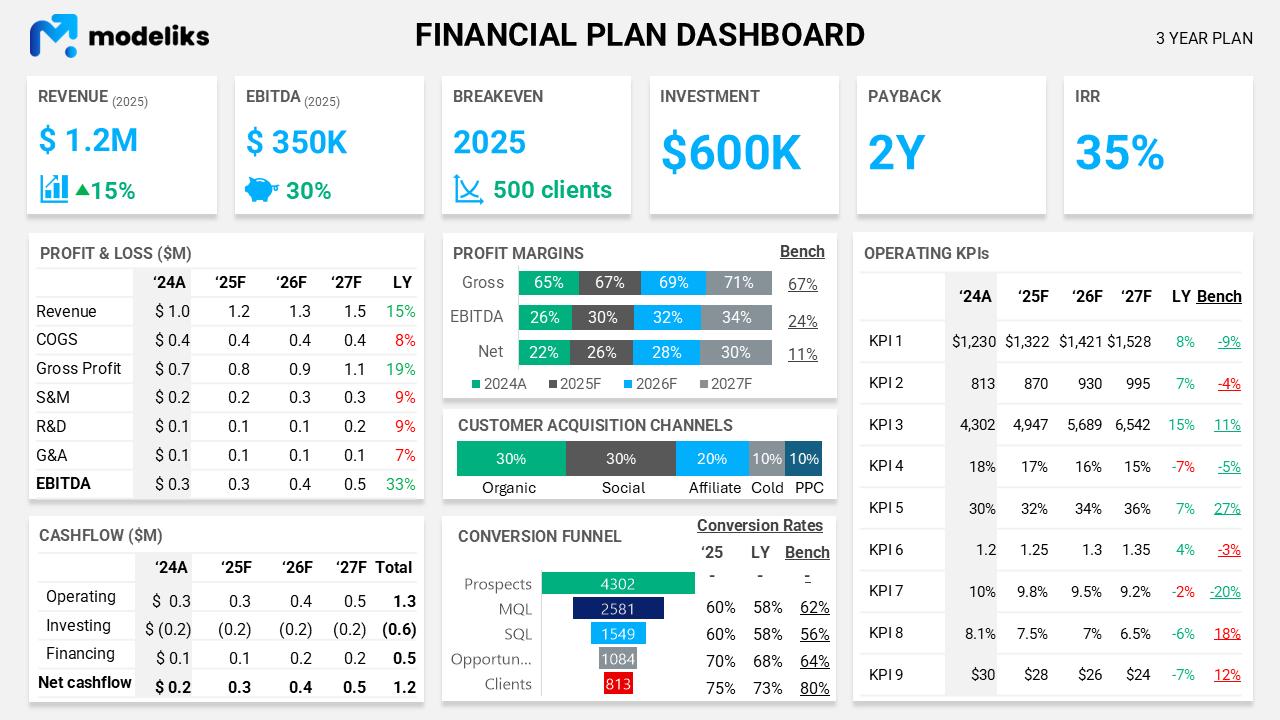Our Educational Content Creation Financial Model Structure covers all the essential aspects you need to consider when starting or scaling a Educational Content Creation business. By following this structure, you can better understand your revenue streams, costs, and assets, helping you optimize profitability and strategically plan for growth.
Starting or growing an Educational Content Creation business requires a thorough understanding of its financial dynamics. Crafting a financial model is essential as it provides insights into potential revenues, direct costs, employees, expenses, and assets needed to run the business efficiently. This model can also help you identify new, lucrative revenue streams that could enhance the profitability of your Educational Content Creation endeavor. Although the Educational Content Creation financial model structure is complex, it is crucial for success. However, many entrepreneurs overlook this aspect because they focus solely on content quality.
The Educational Content Creation financial model structure
Revenues
Typical revenue streams in an Educational Content Creation business consist of:
- Online Course Sales: Calculated by multiplying the price of each course by the number of enrolled students.
- Subscription Fees: Determined by multiplying the monthly or annual fee by the number of subscribers.
- Advertising Revenue: Based on the cost per impression (CPI) or cost per click (CPC), depending on the platform used.
- Consulting Services: Can generate income by charging an hourly or per-project rate for expert services related to educational content.
- Merchandising: Contributes revenue through the sale of branded items, which is calculated by the sales price per item multiplied by the number of items sold.
This financial model requires careful consideration of each stream’s potential, because fluctuations in demand can significantly impact overall earnings. Although diverse, these streams must be managed effectively to ensure sustainable growth within the Educational Content Creation financial model.
Cost of goods sold
For the above revenue streams, consider the following costs:
- Online Course Expenses: Costs include platform fees, content creation, and maintenance.
- Content Hosting and Streaming Costs: Expenses incurred from cloud services or data bandwidth.
- Marketing Expenses: Costs associated with promoting courses and subscriptions.
- Materials for Merchandising: Cost to create and store some merchandise.
- Consulting Expenses: Travel and materials costs associated with providing consulting services, however, these can vary greatly.
Although these costs are necessary, they can be substantial. Managing them effectively is crucial for profitability, requiring careful planning and consideration.
Employees
Typical employees needed and their responsibilities:
- Content Creator: Responsible for researching and developing educational material.
- Marketing Specialist: Manages advertising and audience growth strategies.
- Sales Manager: Focuses on increasing subscriptions and course sales.
- Technical Support: Ensures smooth platform operation and addresses technical issues.
- Finance Officer: Handles budgeting, finance tracking, and reporting activities.
Operating expenses
Operating expenses include:
- Software Licenses: Fees for tools used to create and distribute content.
- Marketing and Advertising: Budget for campaign promotions across various channels.
- Utilities: Costs linked to office spaces like electricity and internet.
- Travel and Accommodation: For events, conferences, or client consultations.
- Professional Fees: Legal and accounting services.
- Employee Training: Expenses on skill development programs.
- Rent: Cost of leasing office or studio space.
- Insurance: Premiums for protecting business assets and liabilities.
- Subscriptions: Regular payments for online tools and resources.
- Office Supplies: Stationery and other day-to-day operational needs.
Assets
Essential assets include:
- Computers and Software: Necessary for content development and design.
- Video and Audio Equipment: Crucial for high-quality content production.
- Office Furniture: Desks, chairs, and other essentials for workspace setup.
- Cloud Storage: Online data storage for content and business documents.
- Learning Management System: Platform to deliver and manage educational courses. However, the integration of these elements is vital for success.
Funding options
Typical funding options include:
- Personal Savings: Utilizing personal savings can help avoid incurring debt.
- Angel Investors: They can provide crucial seed funding to start the business; however, this can be challenging.
- Venture Capital: Suitable for rapid growth and expansion phases, but the competition is fierce.
- Bank Loans: Traditional funding through financial institutions is an option, although one must be cautious.
- Grants: Seeking government or organization grants focused on education can be beneficial; however, the process is often lengthy.
Driver-based financial model for Educational Content Creation
A professional financial model for an Educational Content Creation business hinges on the key performance indicators ( KPIs ) that drive the business’s operations and growth. This is paramount because it informs decision-making.
Examples of these KPIs include:
- Customer Acquisition Cost (CAC): The amount spent to acquire a customer.
- Lifetime Value (LTV): Total net profit from a customer over time.
- Churn Rate: Percentage of subscribers or customers who discontinue their service.
- Content Engagement Rate: The rate at which users interact with placed content.
- Conversion Rate: Percentage of visitors converting into paying customers.
- Average Revenue Per User (ARPU): Revenue generated per user.
- Profit Margin: Net profit percentage over total revenue.
- Monthly Recurring Revenue (MRR): Regular monthly income from subscriptions.
- Net Promotion Score (NPS): Metric to gauge customer/human loyalty.
Driver-based financial planning involves identifying crucial business activities, known as ‘drivers’, which significantly impact financial results. Constructing financial plans based on these activities is essential. This approach helps link financial outcomes to necessary resources, like personnel, marketing funds, and equipment. However, some may overlook its importance.
If you want to know more about driver-based financial planning and why it is the right way to plan, see the founder of Modeliks explaining it in the video below.
Need a business plan?
Create one with Modeliks AI in the next hour!
AI powered business planning for Startups and SMEs.
The financial plan output
The ultimate aim of generating financial forecast outputs is to ensure stakeholders, whether it’s yourself, management, the board, or investors, can quickly grasp how your Educational Content Creation business will perform in the future. Gain confidence in the comprehensive, realistic, and feasible nature of the plan. Discern the necessary investment needed to implement the plan and anticipate the ROI. To achieve these goals, here is a one-page template on how to effectively present your financial plan.

Apart from this one-page summary of your plan, you will need three projected financial statements:
- Profit and Loss: A document that displays revenue, expenses, and profits over time.
- Balance Sheet: A snapshot of financial standing, highlighting assets, liabilities, and equity.
- Cash Flow Statement: A report detailing cash inflows and outflows to assess liquidity.
Educational Content Creation financial model summary
A well-crafted financial model for an Educational Content Creation business will empower you to thoroughly evaluate your business processes. Determine the resources needed to reach your objectives, set realistic targets, monitor performance, procure required funding, and make informed decisions to manage and expand your business. However, this requires diligence and attention to detail because even small errors can lead to significant consequences. Although the process may seem daunting, the benefits are clear.
If you need help with your financial plan, try Modeliks , a financial planning solution for SMEs and startups or contact us at contact@modeliks.com and we can help.
Author:
Blagoja Hamamdjiev
, Founder and CEO of
Modeliks
, Entrepreneur, and business planning expert.
In the last 20 years, he helped everything from startups to multi-billion-dollar conglomerates plan, manage, fundraise, and grow.

TAKE MODELIKS FOR A SPIN
Not sure which plan?
Start with a 15 days free trial.
You will have access to the full functionality of Modeliks. The only restriction in the free trial is that you cannot download or share your business plan outside Modeliks. Credit card is not required to subscribe for the free trial.






